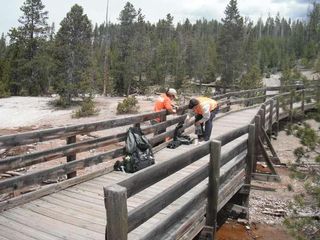
New Sensors Take Yellowstone Geysers' Temperatures

A new sensor network installed in Yellowstone National Park this summer is giving scientists and the public real-time temperature readings from geysers and hot springs in the park's Norris Geyser Basin.
Ten new, radio-equipped sensors were installed at different spots within the geyser basin, recording temperatures within runoff channels from Yellowstone's geysers , hot pools, soils, and air. Data gathered by the new sensors are transmitted to the U. S. Geological Survey offices in Menlo Park, Calif., and will be accessible within 24 hours of measurement, allowing for rapid assessment of changing conditions.
The information will help scientists track temperature changes in local streams that might correlate with seismic tremors, and help Park officials keep an eye on thermal features for educational and safety purposes.
"This innovative use of new technology will allow the public, park staff, educators, and scientists to observe temperature variations in Norris Geyser Basin, one of Yellowstone's more dynamic geyser basins," said Yellowstone geologist Henry Heasler.
Yellowstone's existing temperature sensors, which have been operational for about eight years, lack the ability to transmit, making it necessary to visit sensors to retrieve their data.
The project required unique equipment not readily available. The radios transmitting the data had to be small, with unobtrusive antennas so that the equipment could be placed beneath boardwalks and within small rock piles. The radio signal had to be strong enough so that a day's worth of temperature data could be sent nightly to a base station up to half-a-mile away, and the equipment had to be able to withstand acid waters, steam and sub-freezing temperatures during Yellowstone's notorious winters.
"We've tried to make the system as robust as possible," said Jake Lowenstern, the scientist in charge of the Yellowstone Volcano Observatory (YVO).
Sign up for the Live Science daily newsletter now
Get the world’s most fascinating discoveries delivered straight to your inbox.
The temperature-sensor network is part of increased monitoring of Yellowstone by the USGS and its YVO partners at the University of Utah and Yellowstone National Park. This summer the observatory also upgraded seismic equipment, installed a mobile webcam, and deployed water-sampling equipment in rivers around the park.
Most Popular


